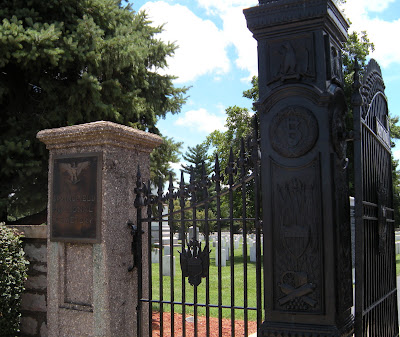This is the gate going into the Springfield National Cemetery located in Springfield, MO.
This is one of two statues located here. Found on the Union side of the cemetery. It is placed high on a pedestal and I was unable to photograph the whole thing at once.
This is the information I found on this monument:
This is the inscription that was on the bottom of the pedestal for the above statue.
***
This is one of the few tall markers in the cemetery, standing approximately 12 to 14 ft tall. Belonging to the Union General Nath Lyon who fell during the battle of Wilson Creek. There were 501 Confederate soldiers that died of wounds or sickness at the Battles of Wilson Creek and Springfield.
Information I found for this marker:
The U.S. government erected this marker 1888 in memory of Brig. Gen. Nathaniel Lyon, served during the Civil War.
***
This monument is located on the Union side of the cemetery.
***
This is the second of two statues in the cemetery, approximately 15 feet tall, is topped by a larger-than-life-size bronze figure of a Confederate soldier approximately ten feet tall.
This is the information I found for this monument:
On Aug. 10, 1901,this bronze figure was dedicated in honor of Missouri soldiers and Gen. Sterling Price, a Confederate officer during the Civil War. The sculptor was Chevalier Trentanove of Italy. The United Confederate Veterans of Missouri sponsored this monument.
***
This is a photo on the Confederate side of the cemetery. Nearly all these markers going back to the wall say "Unknown Soldier CSA".
***
As you go deeper into the cemetery you find monuments to different wars.
This memorial is for those who lost their lives in attack on Pearl Harbor. This memorial was dedicated on Aug. 8, 1992
(This photo was taken by my daughter Katie)
*****
HISTORICAL INFORMATION
Springfield National Cemetery is located on what was once the Kickapoo Prairie in Green County, Mo.
Settlers began arriving in southwest Missouri in 1822, making their way north up the James River and its tributaries. But it was only after removal of the Kickapoo and Delaware Indians in 1830 that permanent settlement became possible. John Polk Campbell is credited as the founder of Springfield. He arrived with his brother Madison in 1829, and upon finding a viable water supply carved his initials on an ash tree to establish his claim. Other settlers arrived almost daily and it was not long before a settlement developed, complete with stores, mills, a school and post office. By 1838 the town had been officially incorporated.
In 1861, Springfield was the site of the Missouri State Convention to determine its future as part of the Union. The governor favored secession. Delegates urged approval of the Crittendon Resolutions (then before Congress), which would have legalized slavery where it already existed, and would let new states decide their own rights and would reimburse slave owners for losses caused by abolitionist raids. Delegates ultimately decided against secession and opposed any military action by either side; but if the federal government declared war on the South, they would join the Confederate ranks.
The Battle of Wilson Creek, the first major Civil War engagement west of the Mississippi River, was fought in Springfield on Aug. 10, 1861, and involved about 5,400 Union troops and 12,000 Confederates. Although the battle was a Confederate victory, the South failed to capitalize on its success; it led to greater federal military activity in Missouri and set the stage for the Battle of Pea Ridge in March 1862.
Many men who died at the Battle of Wilson Creek would eventually be buried at Springfield National Cemetery, established in 1867 when the city purchased five acres for a burial plot. In 1911, the Confederate Cemetery Association (CCA) donated six acres, two of which were enclosed by a stone wall. Along with the land came the provision that burials would be restricted to men who died serving the Confederacy. Through a series of amendments to this provision in 1948, 1957 and 1984, all eligible veterans are now permitted in this portion of the cemetery. An 1871 cemetery inspection report recorded 832 known and 689 unknown interments in the cemetery. It continued, “A very worthless superintendent was in charge last year, and the cemetery was sadly neglected. This year it has been put in good order.”
Springfield National Cemetery was listed on the National Register of Historic Places in 1999.
Now for a tidbit of fun information. According to the website Dark Destinations they say that there are ghosts at this location. Here is what they say:
The Springfield National Cemetery is also host to more than a few lingering spirits as well, according to some people. Late-night visitors to the cemetery have reported seeing gravestones that appeared to glow in the dark. Yet others have reported finding strange anomalies in photographs they took while inside the cemetery grounds. On occasion, some photographs even show what appears to be an apparition or form of some long-dead solider standing amongst the tombstones.
















Good Job. That is a very interesting cemetery with a lot of artwork.
ReplyDeleteI literally just came back from national/Hazelwood cemetery and I found strange noises during evp session and I also took 10.pictures an on there there are strange anomalies one was a dark mist the other 2 had strange white apparitions creepy.
ReplyDelete